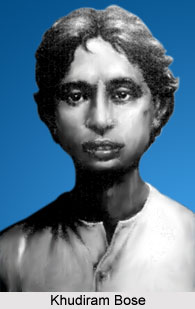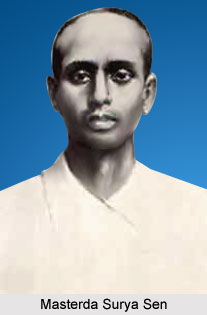 The background of Chittagong Armoury Raid Case spans over a decade as the members of the Indian Republican Army took several preparations for the successful implementation of the revolutionary plans. The Chittagong Revolutionary Group was an ideal combination of thinkers and doers, such as, Masterda Surya Sen, who was the leader, Lokenath Bal, Ananta Singh, Kalpana Dutta, Ambika Chakrobarty, Pritilata Waddedar, Ganesh Ghosh, Anand Gupta, Jiban Ghoshal, Tarakeswar Dastidar, Harigopal Bal (Tegra), Ardhendu Dastidar, Sasanka Datta, Naresh Roy, Subodh Roy and Nirmal Sen. By the year 1918, Surya Sen, along with Charu Bikash Datta, Ambika Chakrabarti and others established a separate revolutionary group in the region of Chittagong.
The background of Chittagong Armoury Raid Case spans over a decade as the members of the Indian Republican Army took several preparations for the successful implementation of the revolutionary plans. The Chittagong Revolutionary Group was an ideal combination of thinkers and doers, such as, Masterda Surya Sen, who was the leader, Lokenath Bal, Ananta Singh, Kalpana Dutta, Ambika Chakrobarty, Pritilata Waddedar, Ganesh Ghosh, Anand Gupta, Jiban Ghoshal, Tarakeswar Dastidar, Harigopal Bal (Tegra), Ardhendu Dastidar, Sasanka Datta, Naresh Roy, Subodh Roy and Nirmal Sen. By the year 1918, Surya Sen, along with Charu Bikash Datta, Ambika Chakrabarti and others established a separate revolutionary group in the region of Chittagong.
During late 1925, when most of the leaders of the 2 foremost revolutionary groups of Bengal, Jugantar and Anushilan Samiti, were jailed, the Chittagong revolutionary group, known as the Indian Republican Army remained active. Nirmal Sen, one of the members of the group, acquired expertise in smuggling weapons and ammunitions to Chittagong from the Far East. After the British Intelligence Branch gained information of the smuggling procedure, Sen was arrested while he was on a trip to Chittagong in the year 1926. Surya Sen and other leaders recruited number young and teenaged boys who were enthusiastic about the revolutionary movement during 1928. Nirmal Sen was a friendly and compassionate leader. Nirmal Sen acted as the defence minister of the Indian Republican Army, while Ambika Chakrabarti operated as the foreign minister and also managed finance.
The objective of the group was to achieve freedom from the British Empire in India by aggressive and violent revolutionary means. This idea was already intensely entrenched in the mind of the "Hindu bhadralok" youths of the time. Even though the first political assassination of a British official, Chairman of Plague Commission- W.C.Rand, and a bystander Lieutenant C.E. Ayerst, was undertaken in Poona (presently known as Pune) in the year 1897, the thought of armed struggle for national freedom thrived and developed in Bengal. After the triumphant Battle of Plassey in the year 1757, Bengal was the base of British East India Company and the colonial rule. This deeply influenced the populace of the Bengal province, especially profoundly affected the people of the province, particularly the upper caste intellectuals. The associations between the Bengali intellectuals and the British led to the Bengal renaissance during the middle of the 19th century.
After the Arms Act of 1878, the native populace of the country was forbidden from possessing fire-arms and weapons, while the British Indian army, Police and other Europeans officials in the country retained highly sophisticated and technically advanced weapons that were in existence during that period. This Act motivated the Chittagong revolutionaries further for military and physical prowess in order to challenge and confront the British Empire in India. Several akharas or gymnasiums and secret societies emerged in Calcutta (now Kolkata) during the 1870s, but these soon waned and died out. The Indian National Congress was established in 1885 but its polite attitude towards the foreign rule, and politics through resolutions and petitions were much less inspiring as compared to the actions and ideals of the revolutionaries. During the initial years of the 20th century that the concept of confronting the British power with the use of weapons were materialized. During this period, various clubs appeared in Calcutta with the objective of providing military and physical training and nationalist principles. Although none of these organisations were explicitly revolutionary, they provided the base for the revolutions.
On 30 April 1908, Prafulla Chaki and Khudiram Bose bombed a horse carriage in Muzaffarpur in an attempt to murder Douglas Kingsford, the former Chief Presidency Magistrate of Calcutta, but instead killed 2 Englishwomen. Khudiram Bose was hanged and Prafulla Chaki committed suicide. Moreover in the Alipore Bomb Case Trial, various freedom fighters like Barindra, Aurobindo and others were detained by the British police. Khudiram Bose and another revolutionary named Kanailal Dutt became heroic martyrs and inspirations for the young revolutionaries of Chittagong and other Bengali youths as well. But the Indian Republican Army never aimed for political murders of British officials. Even during extensive arrests and detentions under a range of oppressive laws, the revolutionary group of Masterda Surya Sen never lacked members as new recruits continuously joined the armed revolt movement. Several arrests were made under a host of exploitive laws, like the Defence of India Act 1915, but these groups never lacked new members and their leaders were never out of new plans for aggressive revolt. The plan for a national uprising was perhaps the most grand of these, which took advantage of the concern of the British Empire during World War I.
The first stage of the revolutionary freedom struggle concluded with the end of the Great War in 1918. Most of the leaders in the Presidency of the Anushilan Samiti and the Jugantar party were arrested, hanged or sentenced to transportation for life to Port Blair. During this period the revolutionary activities came to a halt, but numerous groups, set up by young natives throughout Bengal, remained devoted towards armed revolution as they believed that it was the sole way of acquiring independence from the British dominion.
In the year 1920, Mahatma Gandhi initiated the Non-Cooperation Movement, which urged the native population to boycott British titles, schools and colleges, councils, courts and foreign goods. He also requested the people to take constructive work by establishing national educational institutes, arbitration courts and developing unity between Hindu and Muslim and the elimination of untouchability. These resolutions greatly influenced Surya Sen and his associates, who commenced from the foundation and evolved their revolutionary ideals. The group aimed to associate with the Jugantar party or the Anushilan Samiti. Accordingly Surya Sen and most of his friends became a member of the Jugantar party, as it was not much centralized and separate groups had significant independence within its flexible structure.
All detenus under the Defence of India Act were released, along with the leaders of the national revolutionary movements, after the Royal Proclamation in 1919. The members of the Jugantar Party in Bengal joined the Indian National Congress district committees and operated as volunteers. During this period, Surya Sen, Ambika Chakrabarti, Ananta Singh, Ganesh Ghosh and their other associates came under the leadership of J.M. Sengupta, who was an eminent lawyer and a follower of Mahatma Gandhi. As the Chittagong revolutionary group completely immersed itself in the Non Cooperation Movement of Gandhi, they became extremely disappointed after Mahatma Gandhi abolished the movement on 11 February 1922, due to the violence in Chauri Chaura.
This decision of Gandhi made the previously committed volunteers to opt for other action oriented principles and methods of attaining independence to properly utilise the rising militant spirit awakened among the native population. Several communist groups were formed in different regions of the nation and the idea of revolutionary terrorism was also revived after the February decision. Master-Da Surya Sen assumed the decision to recommence violent methods during the Chittagong Congress of April 1922. The Indian Republican Army was in the second stage of the movement and was determined to collect finance by robbing the British administration, purchasing ammos and ammunitions, manufacturing bombs, developing associations with other groups in Bengal to conduct simultaneous uprisings.
The members of the Indian Republican Army took various preparations for Chittagong Armoury Raid like establishing physical training clubs in Chittagong and gathering funds to purchase fire-arms. Nogendra Sen, who was an ex-soldier, gave basic military training to the members of the Chittagong revolutionary group who conducted the Chittagong uprising. The British government of Bengal issued an ordinance on 25 October 1924 and many such revolutionaries were detained. Subhas Chandra Bose was also arrested under the ordinance. Several members of the Chittagong group were arrested under the ordinance but Surya Sen managed escape the British police for almost 2 years.
 After 2 years, Surya Sen and other important members of the Indian Republican Army were released and gathered in the town of Chittagong. They were trained to operate revolvers, manufacture sophisticated bombs, and fight with the British police and hide underground. The leader of the Chittagong revolutionary group, Masterda Surya Sen had learnt several valuable lessons from the past years. The ideas of a nationwide uprising had drastically failed, confidential information were to the British authorities, valuable time was wasted on planning of gathering of funds through robberies and purchase of arms and ammunitions.
After 2 years, Surya Sen and other important members of the Indian Republican Army were released and gathered in the town of Chittagong. They were trained to operate revolvers, manufacture sophisticated bombs, and fight with the British police and hide underground. The leader of the Chittagong revolutionary group, Masterda Surya Sen had learnt several valuable lessons from the past years. The ideas of a nationwide uprising had drastically failed, confidential information were to the British authorities, valuable time was wasted on planning of gathering of funds through robberies and purchase of arms and ammunitions.
The prominent members of the group in Chittagong decided to operate independently and separately to successfully carry out a remarkable uprising. It was further decided that the group will not be involved in any robberies, arms smuggling and they would not depend on the renowned leaders in Calcutta either. The revolutionaries resolved to produce their own funds and construct an army that would share their ideals of national independence through armed revolution. Master-Da Surya Sen was determined to conduct small revolutionary activities that will be carried out successfully, instead of wasting more time on attaining an all India revolt.
The members of the Chittagong revolutionary group, the Indian Republican Army, given their past dissatisfaction with Mahatma Gandhi and the Indian National Congress, again felt let down by them. They were further convinced that the Congress would be unable to provide the lead at this critical point. The prominent members of the group decided to conduct a impressive action that would provide a spectacular and inspiring instance to the people of the nation, especially the youth of the country. The leaders of the Indian Republican Army in Chittagong recruited new members and trained them in order to plan every detail and take proper preparations for Chittagong Armoury Raid case. Moreover, some of the members of the group were skilled in the usage of arms and weapons, where as some other members achieved expertise in political activities for the successful implementation of the plan.



















